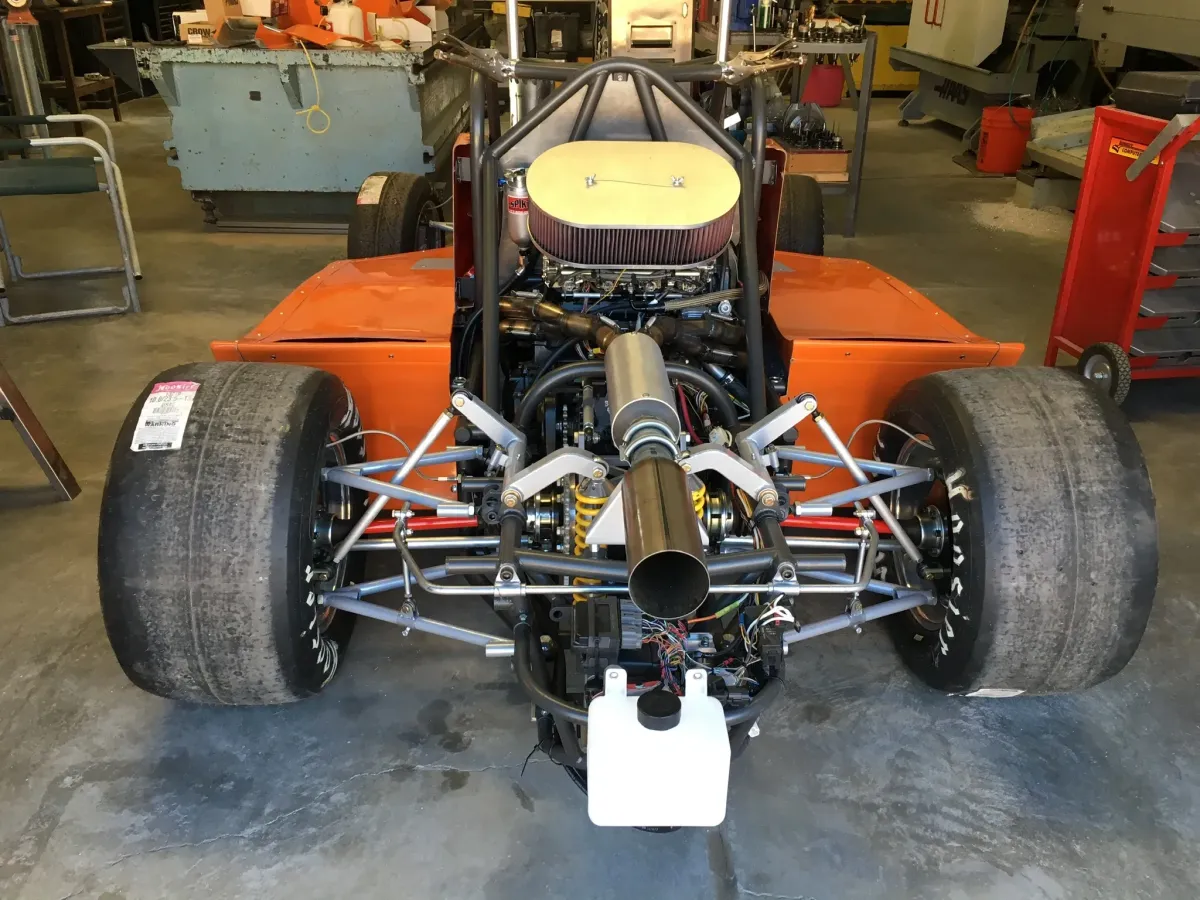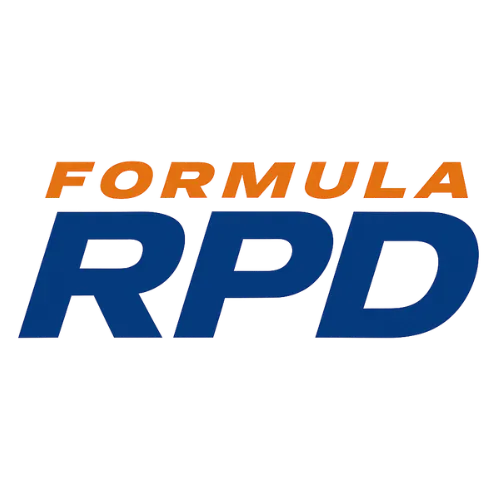Description
Formula RPD is a new racing class based on a car built by Walt Boyd Racing in Apple Valley, California. RPD is an acronym for Road courses, Paved ovals, and Dirt ovals - the three different types of venues the car is designed to run on.

Specifications:
Formula RPD is a racecar that is purposefully designed to run on road courses, paved ovals, and dirt ovals:
Wheelbase…………………………………………………………..81”
Maximum overall width……………………………………...65”
Weight (less driver and fuel) ……………………….…950 Lbs.
Horsepower...………………………...….….………….210 to 225
Wheelbase………..81”
Maximum overall width………...65”
Weight (less driver and fuel)….…950 Lbs.
Horsepower...…….………….210 to 225
General description of the car:
Open wheel, rear (mid) engine, powered by a Kawasaki ZX14 engine
Independent suspension front and rear
Inboard coil-over springs/shocks
Tig welded chrome moly steel tube frame, with roll cage
Lightweight, hand laid-up, fiberglass body
Bumpers front and rear, nerf bars inside side pods
Quick-change ratio, adjustable assist, power rack-and-pinion steering
10.5” scalloped, vented rotor brakes
Chain drive with torque biasing differential
13” x 8” front wheels, 13” x 10” rear wheels
Two midget radiators (one in each side pod)
Adjustable wings front and rear
Purpose made, owner configurable, ECU/data display
Six-speed gearbox, torque sensing differential, and big brakes (features need on road courses)
Roll cage, bumpers and nerf bars, quick change drive ratio capability (features needed on paved ovals)
Short wheelbase, lots of wheel travel, fast, adjustable assist power steering with lots of steering lock (features needed on dirt tracks)
a racecar that has a high-performance engine/clutch/gearbox package that makes both initial cost and maintenance costs a small fraction of what those costs normally are,
a race car that is designed for safety and repairability. The design incorporates many driver protections yet is readily repairable. The tube frame is very strong, but there are crushable (and readily replaceable) components all around.
a “spec” race class, but one with very few rules, allowing competitors total freedom within a wide range of adjustments,
a way to get both road race experience and rear-engine experience, not to mention all the valuable techniques of short-track pavement and dirt racing, a racing class where there is a purse, and it is easy for competitors to get sponsors.
In oval track racing there are spectators. That’s not the case with road racing except at the highest levels of the sport.
About Engines
You are welcome to provide your own engine for us to install. Alternatively, we can sell one to you.
We source used engines online, typically for between $4,000 and $5,000, plus shipping. The final price depends on the engine's year and mileage, with shipping costs varying by location. We will sell you an engine for 10% above our acquisition cost.
Please note that all engines are sold with absolutely no warranty or guarantee. As a courtesy, we can cut open the oil filter to inspect for metal debris. The choice is yours: you can gamble and run the engine as-is, or you can choose to rebuild and modify it (within the rules) before bringing it to us for installation.
You can bring us an engine, and we will install it. Or we can sell you one.
We buy used engines on-line for typically $4,000 to $5,000, plus shipping. The cost of engines varies depending on the year and mileage. Shipping varies depending upon where it’s coming from. We will sell you one for 10% over our cost. We sell engines with absolutely no guarantee. (We can cut the oil filter up and see if there is any metal in it.) It’s your choice to gamble and run it as-is or rebuild it and do whatever modifications you want (within the rules, of course), then bring it back, and we will install it.
Anticipated Race BudgetsBased on actual experience with other open wheel, motorcycle-engine based classes, we estimate that you should be able to field a competitive car for somewhere between $500 and $1,500 per race (not counting offsetting money you might win). Obviously, there are a lot of variables. One would be where you live relative to where most of the races are. Another would be how much maintenance and repair work you do yourself.
We haven’t finalized tire rules yet. It’s difficult—not necessarily impossible—to make tire rules that totally eliminate the advantage of an unlimited tire budget. We’re working on that.
You can bring us an engine, and we will install it. Or we can sell you one.
We buy used engines on-line for typically $4,000 to $5,000, plus shipping. The cost of engines varies depending on the year and mileage. Shipping varies depending upon where it’s coming from. We will sell you one for 10% over our cost. We sell engines with absolutely no guarantee. (We can cut the oil filter up and see if there is any metal in it.) It’s your choice to gamble and run it as-is or rebuild it and do whatever modifications you want (within the rules, of course), then bring it back, and we will install it.
You can bring us an engine, and we will install it. Or we can sell you one.
We buy used engines on-line for typically $4,000 to $5,000, plus shipping. The cost of engines varies depending on the year and mileage. Shipping varies depending upon where it’s coming from. We will sell you one for 10% over our cost. We sell engines with absolutely no guarantee. (We can cut the oil filter up and see if there is any metal in it.) It’s your choice to gamble and run it as-is or rebuild it and do whatever modifications you want (within the rules, of course), then bring it back, and we will install it.
Anticipated Race BudgetsBased on actual experience with other open wheel, motorcycle-engine based classes, we estimate that you should be able to field a competitive car for somewhere between $500 and $1,500 per race (not counting offsetting money you might win). Obviously, there are a lot of variables. One would be where you live relative to where most of the races are. Another would be how much maintenance and repair work you do yourself.
We haven’t finalized tire rules yet. It’s difficult—not necessarily impossible—to make tire rules that totally eliminate the advantage of an unlimited tire budget. We’re working on that.
Anticipated Racing Budgets
Based on actual experience with other open-wheel, motorcycle-engine-based classes, we estimate a competitive season can be run for between $500 and $1,500 per race, excluding any potential winnings.
This figure, of course, depends on several variables. Your location relative to the race venues and the amount of maintenance and repair work you perform yourself will be significant factors.
We have not yet finalized the tire rules. Creating regulations that eliminate the advantage of an unlimited tire budget is challenging, though not necessarily impossible, and it remains a priority we are actively working on.
We are going to offer a rent-to-purchase plan whereby a buyer can rent a car initially and apply the rental fees toward the ultimate purchase. The rental cars will be fully assembled, of course. We are going to sell the first 10 cars at about half of what they ultimately will cost. We haven’t established a price for a turnkey car, which is what the rental cars will be, but it will have to be close to $100,000. (Racecars are rarely sold that way because the finish assembly adds so much to the cost, and even with a spec class there are many things an owner can personalize.)
The rental fee/purchase price will be individually negotiated because it involves a lot of issues: How much racing experience does the driver have? Who transports the car to the track? How are the tire costs handled? Who does the maintenance and race prep (and what kind of experience do they have)? But the cost of the first 10 cars will be in the range of $50,000, with the per race rental in the vicinity of $2,500. There will be a crash damage deposit required, but whatever is not used to cover crash damage can be applied to the purchase cost.
The rent-to-own program will amount to a big capital investment by us, but a smokin’ deal for the first 10 buyers, because we will be selling cars way below their actual value.
Prior to our first race we plan to have three practice sessions, one on a road course, one on a paved oval, and one on a dirt track. We will rent the tracks and bring two or three cars. People seriously interested can get some track time without putting a lot of money at risk. (We will require some security deposit to cover potential crash damage, but not a huge amount, only enough to discourage recklessness.) And we are lining up some experienced drivers to be at the track to coach drivers who have no experience on the particular type of racetrack. (Not many drivers are experienced on all three of the different venues this class is designed to run on.)
Note from Walt BoydThis is obviously a very ambitious venture. I have undertaken this whole project in my “retirement” years, largely out of love of the sport, having seen the need for a racing class that affords aspiring drivers who don’t have a whole lot of money, a way to work toward Indy or even F1.

